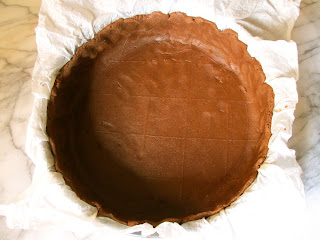 For the Bavarian cream
For the Bavarian cream1.5 dl (0.7 cup) strong espresso or moka coffee
5 egg yolks
200 gr (0.45 lb) sugar plus 2 tablespoons
15 gr (0.03 lb) of gelatin in sheets
5 dl (2.1 cups) heavy cream
One vanilla bean
One teaspoon of powdered sugar
One orange
For the biscotti
250 gr (0.55 lb) dark chocolate
125 gr (0.27 lb) whipped butter
110 gr (0.25 lb) sugar
2 eggs
35 gr (0.08 lb) flour
Pour the milk into a saucepan with the coffee and the vanilla bean halved lengthwise. Bring to a boil, remove from heath and remove the
vanilla bean. Place the
gelatin sheets in a bowl with cold water for 5-10 minutes. Beat the egg yolks with the sugar in a heavy bottomed saucepan, slowly add the hot milk, and put the pan on low heat stirring gently and making sure it does
not boil. Wring gently the gelatin to remove excess water, add it to the hot mixture, stirring
until dissolved, then remove from heat and pass the cream through a mesh strainer to filter out any
residue. The cream does not really need to cook or thicken; the purpose is to
melt the sugar and the gelatine sheets.

Put the bowl with the warm cream in a larger contained filled with ice water and let the mixture cool, stirring often. When the cream is chilled and has begun solidifying, combine it with the whipped heavy cream. As a general rule, when mixing two creams of different consistency, always add the more liquid one to the thicker.
Transfer the mixture into a 1.5-liter mold or into 6 single-portion molds and refrigerate for at least 3 hours.
Prepare the biscotti cutting 125 gr (0.27 lb) of chocolate into small pieces and melting it in a bain-marie. While the chocolate melts, add the sugar to the whipped butter; then incorporate the eggs, the flour and the melted chocolate.
Place a 15in-by-11in silicone baking mat over an oven grid and transfer the mixture over the mat. You can also use a large sheet pan, but while the baking mat is non-stick, you will need to grease the regular pan with a thin layer of butter and then cover it with some flour. With the help of a spatula spread the mixture over the mat leaving one inch of free space on each side.
Bake for about 30
minutes at 180ºC (350ºF). While the mixture is still warm, place the mat over a
flat surface and cut the pastry into pieces approximately 2in. by 4in. Once the
biscotti are cold, melt the remaining chocolate in a bain-marie, dip each of
them half-way deep in the chocolate (lengthwise) and let them rest on a sheet
of parchment paper until dry.
Dissolve the remaining 2 tablespoons of sugar in a tablespoon of water on low heat. Dip the yellow part of the orange peel, cut into thin slices, in the syrup, remove the peel after a few minutes and leave to cool on a sheet of parchment paper.
Turn out the Bavarian on a plate and decorate with the biscotti, the orange zest and a few thin slices of orange.









































